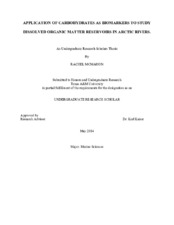| dc.creator | McMahon, Rachel | |
| dc.date.accessioned | 2014-06-16T15:51:25Z | |
| dc.date.available | 2014-06-16T15:51:25Z | |
| dc.date.created | 2014-05 | |
| dc.date.issued | 2014-01-22 | |
| dc.date.submitted | May 2014 | |
| dc.identifier.uri | https://hdl.handle.net/1969.1/152060 | |
| dc.description.abstract | Arctic rivers are the dominant pathways for the transport of terrestrial dissolved organic carbon to the Arctic Ocean, but knowledge of sources, transformations and transfer of organic carbon and nitrogen in Arctic river watersheds is extremely limited. Here we use chemical analysis of carbohydrates to investigate the bioavailability of dissolved organic matter in five major Arctic river watersheds. In addition, neutral sugar analyses were integrated with existing measured chemical parameters from the PARTNERS data set to identify DOM sources. The results show the bioavailability of DOM in Arctic rivers is strongly correlated with seasons, vegetation topography and water residence time in the watersheds. Pulses of bioavailable DOM are observed in the Siberian rivers during the Spring flood, whereas the Mackenzie River shows extensively degraded DOM throughout all stages of the hydrograph. Δ14C-DOC was not correlated to higher carbohydrate yields possibly indicating export of recently mobilized ancient permafrost organic carbon. | en |
| dc.format.mimetype | application/pdf | |
| dc.subject | Marine Sciences, Arctic Rivers, Chemical Oceanography,Bioavailability, DOM analysis | en |
| dc.title | APPLICATION OF CARBOHYDRATES AND PHENOLS AS BIOMARKERS TO STUDY DISSOLVED ORGANIC MATTER RESERVOIRS IN ARCTIC RIVERS. | en |
| dc.type | Thesis | en |
| thesis.degree.department | Marine Sciences | en |
| thesis.degree.discipline | Marine Sciences | en |
| thesis.degree.grantor | Honors and Undergraduate Research | en |
| dc.contributor.committeeMember | Kaiser, Karl | |
| dc.type.material | text | en |
| dc.date.updated | 2014-06-16T15:51:25Z | |


